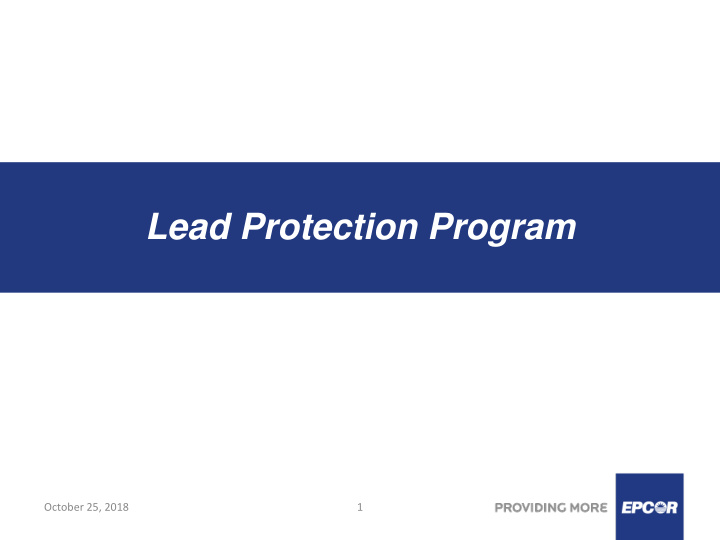



Lead Protection Program October 25, 2018 1
Overview 1. Sources of lead in drinking water at the tap 2. EPCOR’s current lead control program 3. Upcoming changes in federal drinking water guidelines 4. Changes to lead control program being considered 5. Next steps October 25, 2018 2
Sources of Lead at the Tap 1. Lead Service Lines 2. Building Plumbing October 25, 2018 3
Current EPCOR Lead Program - Since 2008 Annual notification of residents in approx. 5,000 homes (1%) with LSLs Testing for lead at the tap Provision of faucet/pitcher filters to remove lead Targeted replacements of EPCOR-owned section of the LSL > 1,800 replaced in 10 years, mostly partial LSL replacements (EPCOR-owned section) Communication materials and info for customers Random daytime (RDT) sampling to assess lead in all homes across the city based (since in 2015) October 25, 2018 4
Upcoming Federal Lead Guideline Health Canada is considering new information on health effects of lead, especially in young children Maximum Acceptable Concentration for lead in drinking water will be reduced 10 ug/L 5 ug/L Point of monitoring and compliance will be at the tap Expect final release in 2019 Will impact all water utilities across Canada October 25, 2018 5
What Our Lead Testing Data is Telling Us • For our random daytime testing program (2015 – 2018), we collected one-litre water samples directly from kitchen faucets in homes across the city at random times during workdays. Compiled Results from EPCOR’s Random Daytime Sampling Program 2015-2018 Samples were collected without any kind of flushing. This • kind of sampling is designed to specifically measure the impact of building plumbing on water at the tap. • EPCOR proactively collected these samples to determine how much lead would be contributed to water at the tap from building plumbing. • The current Health Canada Canadian Drinking Water Guideline for lead guideline is 0.010 mg/L ,and there is no requirement for this kind of sampling in the current guideline. The 0.005 mg/L (or 5 ppb) is the proposed new guideline. This kinds of sampling is recommended in the proposed new Health Canada guideline. • Based on our random daytime testing, about 50 % of homes with LSLs and 13% of all other homes will not meet the new lead guideline. October 25, 2018 6
Options EPCOR Is Evaluating to Reduce Lead at the Tap • Addition of orthophosphate to the Edmonton Corrosion drinking water to reduce lead in all homes and Control from all sources (LSLs, plumbing) • Accelerating LSL removal Accelerated • Eliminate partial LSL replacements LSL • Explore funding of private service line replacements Removal • Cost split: 70% utility, 30% home owner Better • Improved filter program for homes with LSLs as an Filters interim measure to reduce lead at the tap October 25, 2018 7
Significant Achievements in 2018 YTD • Pilot-testing of orthophosphate addition Corrosion • Evaluation of environmental impacts Control • Started conceptual design of dosing syste m Accelerated • Industry / jurisdictional review LSL • Field testing of coordinated LSLs (utility/private) Removal replacements Better • Pilot-testing under-the-counter filters in several Filters homes with LSLs October 25, 2018 8
Next Steps Determine financial cost and rate impact of each of the three options Complete full business case for comprehensive program to address lead from all sources Present business case to City Utility Committee in first half of 2019 Develop a communication plan October 25, 2018 9
Recommend
More recommend